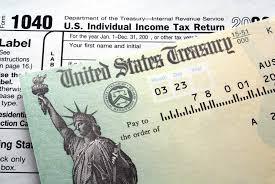Will Your Tax Refund Shrink This Year? Here’s How to Find Out

Should you be worried about what the new tax law—a.k.a. the 2017 Tax Cuts and Jobs Act—means for your 2018 refund?
The early reports from the Internal Revenue Service have been a mixed bag: In February, weekly data showed that the value of refunds, on average, was down compared to last year—by as much as 16.7%. But that trend seems to have shifted, with the latest stats (from the week of March 8), revealing that the average check was in-line with the 2017 tax year.
But even if you do end up with a smaller refund this year, that doesn’t necessarily mean you’re paying more in taxes, says Mark Steber, Jackson Hewitt’s chief tax officer. The issue may actually relate to your withholdings. When new withholding tables were released in February 2018, many employers adjusted the amount that was being removed from workers’ paychecks—a change that left many Americans taking home more each pay period. The new tables are designed, in part, to encourage people to pay the proper amount in taxes throughout the year—a strategy that reduces refunds by design. (After all, when you get a refund, it essentially means you overpaid during the year.)
However, it is possible that your withholdings were actually reduced too much, leaving you facing an unexpected tax bill after you file for 2018. In that case, you’ll want to tweak the amount that’s being held back now, so you don’t face the same predicament next year. Your HR department should be able to help you make that change—consult with your tax pro if you need help identifying the right withholding strategy.
Of course, there are certain groups of taxpayers where the smaller (or non-existent) refund is not simply a matter of fine-tuning withholdings. In many of these cases, the likely culprits are the new rules about deductions, which eliminate many of the write-offs taxpayers have been taking for years—and, in some cases, result in higher overall tax bills.
So, who will likely see smaller tax refunds in 2018?
Sorry, singles
The tax reform bill boosted the amount of the so-called standard deduction: It has jumped from $ 6,350 to $ 12,000 for single filers, and from $ 12,000 to $ 24,000 for married couples filing jointly. This reduced the advantages of itemizing deductions—i.e. listing expenses in order to reduce the amount of income that’s subject to taxation. In fact, the number of people who will file with itemized deductions this year is expected to plunge to 18 million, down from 46.5 million in 2017, according to the Joint Committee on Taxation.
One of the largest groups impacted by this change are single filers who can’t claim a dependent. While some single taxpayers will benefit from the standard deduction boost, those who have historically opted to itemize will now have to find nearly twice as many expenses in order to make itemizing worth their while. Another change that makes that $ 12,000 threshold tougher to hit: The law now bans itemizing some costs—such as unreimbursed work-related expenses like gas—that taxpayers could previously rely on.
Lynn Ebel, director of H&R Block’s Tax Institute, believes that these changes will have more impact among single filers, since the standard deduction doesn’t reduce their taxable income as much when compared to those filing jointly.
On the flip side, those who file jointly and have kids benefit greatly from an increase in the standard deductions, which doubled to $ 24,000. Plus, there’s been in increase in the tax credit that parents earn, which grew from $ 1,000 to $ 2,000 per child.
Homeowners in high tax states lose out
Among the most controversial moves in new tax bill is the capping of how much state and local taxes filers can deduct. That change will have a particularly dramatic effect on higher income taxpayers in high tax states, says Ebel. Under the new rules, they can no longer deduct the cost of state taxes beyond $ 10,000 on their federal income statements. And the situation is even bleaker for those higher income taxpayers with expensive homes, since the new rules also cap how much mortgage interest one can deduct.
For those living in states without income taxes, like Florida or Texas, the rule changes aren’t as painful, no matter your income bracket.
Not too charitable to givers
One of the perks of giving to charity has long been the ability to do some good and then write off the donation on your taxes. But because the standard deduction moved higher, those who donate will have to give more in order to see the impact.
Under the previous rules, a filer who itemizes deductions, files jointly, and had $ 10,000 in expenses, plus $ 5,000 in donations, would have paid less in taxes by itemizing her expenses. But this year, that same person would instead take the standard deduction of $ 24,000—and the charitable gift would have no tax benefit.
There is a way to harness your giving going forward, says Colleen Carcone, director of wealth planning strategies at TIAA-CREF: Bundling several years worth of donations into a single year. So, in the example above, if the taxpayer could earmark $ 20,000 for charity in 2019 (assuming it’s less than 60% of her adjusted gross income), she would be able to push her total itemized deductions past that $ 24,000 mark and reap the tax benefit.
That’s a big bump, obviously, but consider the good it could do—both for the charities you love and for your 2019 tax bill.






